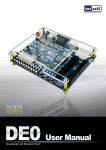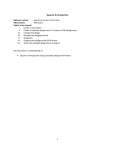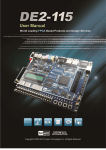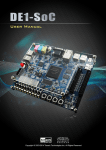Download DE2 Development and Education Board User Manual
Transcript
DE1 User Manual Chapter 4 Using the DE1 Board This chapter gives instructions for using the DE1 board and describes each of its I/O devices. 4.1 Configuring the Cyclone II FPGA The procedure for downloading a circuit from a host computer to the DE1 board is described in the tutorial Quartus II Introduction. This tutorial is found in the DE1_tutorials folder on the DE1 System CD-ROM, and it is also available on the Altera DE1 web pages. The user is encouraged to read the tutorial first, and to treat the information below as a short reference. The DE1 board contains a serial EEPROM chip that stores configuration data for the Cyclone II FPGA. This configuration data is automatically loaded from the EEPROM chip into the FPGA each time power is applied to the board. Using the Quartus II software, it is possible to reprogram the FPGA at any time, and it is also possible to change the non-volatile data that is stored in the serial EEPROM chip. Both types of programming methods are described below. 1. JTAG programming: In this method of programming, named after the IEEE standards Joint Test Action Group, the configuration bit stream is downloaded directly into the Cyclone II FPGA. The FPGA will retain this configuration as long as power is applied to the board; the configuration is lost when the power is turned off. 2. AS programming: In this method, called Active Serial programming, the configuration bit stream is downloaded into the Altera EPCS4 serial EEPROM chip. It provides non-volatile storage of the bit stream, so that the information is retained even when the power supply to the DE1 board is turned off. When the board's power is turned on, the configuration data in the EPCS4 device is automatically loaded into the Cyclone II FPGA. The sections below describe the steps used to perform both JTAG and AS programming. For both methods the DE1 board is connected to a host computer via a USB cable. Using this connection, the board will be identified by the host computer as an Altera USB Blaster device. The process for installing on the host computer the necessary software device driver that communicates with the USB Blaster is described in the tutorial Getting Started with Altera's DE1 Board. This tutorial is available on the DE1 System CD-ROM and from the Altera DE1 web pages. Configuring the FPGA in JTAG Mode 24 DE1 User Manual Figure 4.1 illustrates the JTAG configuration setup. To download a configuration bit stream into the Cyclone II FPGA, perform the following steps: x x Ensure that power is applied to the DE1 board Connect the supplied USB cable to the USB Blaster port on the DE1 board (see Figure 2.1) x Configure the JTAG programming circuit by setting the RUN/PROG switch (on the left side of the board) to the RUN position. x The FPGA can now be programmed by using the Quartus II Programmer module to select a configuration bit stream file with the .sof filename extension USB Blaster Circuit Quartus II Programmer USB PROG/RUN MAX 3128 "RUN" JTAG Config Signals JTAG UART Auto Power-on Config JTAG Config Port EPCS4 Serial Configuration Device FPGA Figure 4.1. The JTAG configuration scheme. Configuring the EPCS4 in AS Mode Figure 4.2 illustrates the AS configuration set up. To download a configuration bit stream into the EPCS4 serial EEPROM device, perform the following steps: x x x Ensure that power is applied to the DE1 board Connect the supplied USB cable to the USB Blaster port on the DE1 board (see Figure 2.1) Configure the JTAG programming circuit by setting the RUN/PROG switch (on the left side of the board) to the PROG position. x The EPCS4 chip can now be programmed by using the Quartus II Programmer module to select a configuration bit stream file with the .pof filename extension x Once the programming operation is finished, set the RUN/PROG switch back to the RUN position and then reset the board by turning the power switch off and back on; this action causes the new configuration data in the EPCS4 device to be loaded into the FPGA chip. 25 DE1 User Manual USB Blaster Circuit RUN/PROG Quartus II Programmer AS Mode USB AS Mode Config MAX 3128 "PROG" Auto Power-on Config JTAG Config Port EPCS4 Serial Configuration Device FPGA Figure 4.2. The AS configuration scheme. In addition to its use for JTAG and AS programming, the USB Blaster port on the DE1 board can also be used to control some of the board's features remotely from a host computer. Details that describe this method of using the USB Blaster port are given in Chapter 3. 4.2 Using the LEDs and Switches The DE1 board provides four pushbutton switches. Each of these switches is debounced using a Schmitt Trigger circuit, as indicated in Figure 4.3. The four outputs called KEY0, …, KEY3 of the Schmitt Trigger device are connected directly to the Cyclone II FPGA. Each switch provides a high logic level (3.3 volts) when it is not pressed, and provides a low logic level (0 volts) when depressed. Since the pushbutton switches are debounced, they are appropriate for use as clock or reset inputs in a circuit. Figure 4.3. Switch debouncing. There are also 10 toggle switches (sliders) on the DE1 board. These switches are not debounced, and are intended for use as level-sensitive data inputs to a circuit. Each switch is connected directly to a pin on the Cyclone II FPGA. When a switch is in the DOWN position (closest to the edge of the board) it provides a low logic level (0 volts) to the FPGA, and when the switch is in the UP position it provides a high logic level (3.3 volts). 26 DE1 User Manual There are 27 user-controllable LEDs on the DE1 board. Eighteen red LEDs are situated above the 18 toggle switches, and eight green LEDs are found above the pushbutton switches (the 9th green LED is in the middle of the 7-segment displays). Each LED is driven directly by a pin on the Cyclone II FPGA; driving its associated pin to a high logic level turns the LED on, and driving the pin low turns it off. A schematic diagram that shows the pushbutton and toggle switches is given in Figure 4.4. A schematic diagram that shows the LED circuitry appears in Figure 4.5. A list of the pin names on the Cyclone II FPGA that are connected to the toggle switches is given in Table 4.1. Similarly, the pins used to connect to the pushbutton switches and LEDs are displayed in Tables 4.2 and 4.3, respectively. Figure 4.4. Schematic diagram of the pushbutton and toggle switches. 27 DE1 User Manual Figure 4.5. Schematic diagram of the LEDs. Signal Name FPGA Pin No. Description SW[0] PIN_L22 Toggle Switch[0] SW[1] PIN_L21 Toggle Switch[1] SW[2] PIN_M22 Toggle Switch[2] SW[3] PIN_V12 Toggle Switch[3] SW[4] PIN_W12 Toggle Switch[4] SW[5] PIN_U12 Toggle Switch[5] SW[6] PIN_U11 Toggle Switch[6] SW[7] PIN_M2 Toggle Switch[7] 28 DE1 User Manual SW[8] PIN_M1 Toggle Switch[8] SW[9] PIN_L2 Toggle Switch[9] Table 4.1. Pin assignments for the toggle switches. Signal Name FPGA Pin No. Description KEY[0] PIN_R22 Pushbutton[0] KEY[1] PIN_R21 Pushbutton[1] KEY[2] PIN_T22 Pushbutton[2] KEY[3] PIN_T21 Pushbutton[3] Table 4.2. Pin assignments for the pushbutton switches. Signal Name FPGA Pin No. Description LEDR[0] PIN_R20 LED Red[0] LEDR[1] PIN_R19 LED Red[1] LEDR[2] PIN_U19 LED Red[2] LEDR[3] PIN_Y19 LED Red[3] LEDR[4] PIN_T18 LED Red[4] LEDR[5] PIN_V19 LED Red[5] LEDR[6] PIN_Y18 LED Red[6] LEDR[7] PIN_U18 LED Red[7] LEDR[8] PIN_R18 LED Red[8] LEDR[9] PIN_R17 LED Red[9] LEDG[0] PIN_U22 LED Green[0] LEDG[1] PIN_U21 LED Green[1] LEDG[2] PIN_V22 LED Green[2] LEDG[3] PIN_V21 LED Green[3] LEDG[4] PIN_W22 LED Green[4] LEDG[5] PIN_W21 LED Green[5] LEDG[6] PIN_Y22 LED Green[6] LEDG[7] PIN_Y21 LED Green[7] Table 4.3. Pin assignments for the LEDs. 29 DE1 User Manual 4.3 Using the 7-segment Displays The DE1 Board has four 7-segment displays. These displays are arranged into a group of four, with the intent of displaying numbers of various sizes. As indicated in the schematic in Figure 4.6, the seven segments are connected to pins on the Cyclone II FPGA. Applying a low logic level to a segment causes it to light up, and applying a high logic level turns it off. Each segment in a display is identified by an index from 0 to 6, with the positions given in Figure 4.7. Note that the dot in each display is unconnected and cannot be used. Table 4.4 shows the assignments of FPGA pins to the 7-segment displays. Figure 4.6. Schematic diagram of the 7-segment displays. Figure 4.7. Position and index of each segment in a 7-segment display. 30 DE1 User Manual Signal Name FPGA Pin No. Description HEX0[0] PIN_J2 Seven Segment Digit 0[0] HEX0[1] PIN_J1 Seven Segment Digit 0[1] HEX0[2] PIN_H2 Seven Segment Digit 0[2] HEX0[3] PIN_H1 Seven Segment Digit 0[3] HEX0[4] PIN_F2 Seven Segment Digit 0[4] HEX0[5] PIN_F1 Seven Segment Digit 0[5] HEX0[6] PIN_E2 Seven Segment Digit 0[6] HEX1[0] PIN_E1 Seven Segment Digit 1[0] HEX1[1] PIN_H6 Seven Segment Digit 1[1] HEX1[2] PIN_H5 Seven Segment Digit 1[2] HEX1[3] PIN_H4 Seven Segment Digit 1[3] HEX1[4] PIN_G3 Seven Segment Digit 1[4] HEX1[5] PIN_D2 Seven Segment Digit 1[5] HEX1[6] PIN_D1 Seven Segment Digit 1[6] HEX2[0] PIN_G5 Seven Segment Digit 2[0] HEX2[1] PIN_G6 Seven Segment Digit 2[1] HEX2[2] PIN_C2 Seven Segment Digit 2[2] HEX2[3] PIN_C1 Seven Segment Digit 2[3] HEX2[4] PIN_E3 Seven Segment Digit 2[4] HEX2[5] PIN_E4 Seven Segment Digit 2[5] HEX2[6] PIN_D3 Seven Segment Digit 2[6] HEX3[0] PIN_F4 Seven Segment Digit 3[0] HEX3[1] PIN_D5 Seven Segment Digit 3[1] HEX3[2] PIN_D6 Seven Segment Digit 3[2] HEX3[3] PIN_J4 Seven Segment Digit 3[3] HEX3[4] PIN_L8 Seven Segment Digit 3[4] HEX3[5] PIN_F3 Seven Segment Digit 3[5] HEX3[6] PIN_D4 Seven Segment Digit 3[6] Table 4.4. Pin assignments for the 7-segment displays. 4.4 Clock Inputs The DE1 board includes three oscillators that produce 27 MHz, 24Mhz, and 50 MHz clock signals. The board also includes an SMA connector which can be used to connect an external clock source to the board. The schematic of the clock circuitry is shown in Figure 4.8, and the associated pin assignments appear in Table 4.5. 31 DE1 User Manual Figure 4.8. Schematic diagram of the clock circuit. Signal Name FPGA Pin No. Description CLOCK_27 PIN_D12, PIN_E12 27 MHz clock input CLOCK_50 PIN_L1 50 MHz clock input CLOCK_24 PIN_A12, PIN_B12 24 MHz clock input from USB Blaster EXT_CLOCK PIN_M21 External (SMA) clock input Table 4.5. Pin assignments for the clock inputs. 4.5 Using the Expansion Header The DE1 Board provides two 40-pin expansion headers. Each header connects directly to 36 pins on the Cyclone II FPGA, and also provides DC +5V (VCC5), DC +3.3V (VCC33), and two GND pins. Figure 4.10 shows the related schematics. Each pin on the expansion headers is connected to a resistor that provide protection from high and low voltages. The figure shows the protection circuitry for only four of the pins on each header, but this circuitry is included for all 72 data pins. Table 4.7 gives the pin assignments. 32 DE1 User Manual Figure 4.10. Schematic diagram of the expansion headers. Signal Name FPGA Pin No. Description GPIO_0[0] PIN_A13 GPIO Connection 0[0] 33 DE1 User Manual GPIO_0[1] PIN_B13 GPIO Connection 0[1] GPIO_0[2] PIN_A14 GPIO Connection 0[2] GPIO_0[3] PIN_B14 GPIO Connection 0[3] GPIO_0[4] PIN_A15 GPIO Connection 0[4] GPIO_0[5] PIN_B15 GPIO Connection 0[5] GPIO_0[6] PIN_A16 GPIO Connection 0[6] GPIO_0[7] PIN_B16 GPIO Connection 0[7] GPIO_0[8] PIN_A17 GPIO Connection 0[8] GPIO_0[9] PIN_B17 GPIO Connection 0[9] GPIO_0[10] PIN_A18 GPIO Connection 0[10] GPIO_0[11] PIN_B18 GPIO Connection 0[11] GPIO_0[12] PIN_A19 GPIO Connection 0[12] GPIO_0[13] PIN_B19 GPIO Connection 0[13] GPIO_0[14] PIN_A20 GPIO Connection 0[14] GPIO_0[15] PIN_B20 GPIO Connection 0[15] GPIO_0[16] PIN_C21 GPIO Connection 0[16] GPIO_0[17] PIN_C22 GPIO Connection 0[17] GPIO_0[18] PIN_D21 GPIO Connection 0[18] GPIO_0[19] PIN_D22 GPIO Connection 0[19] GPIO_0[20] PIN_E21 GPIO Connection 0[20] GPIO_0[21] PIN_E22 GPIO Connection 0[21] GPIO_0[22] PIN_F21 GPIO Connection 0[22] GPIO_0[23] PIN_F22 GPIO Connection 0[23] GPIO_0[24] PIN_G21 GPIO Connection 0[24] GPIO_0[25] PIN_G22 GPIO Connection 0[25] GPIO_0[26] PIN_J21 GPIO Connection 0[26] GPIO_0[27] PIN_J22 GPIO Connection 0[27] GPIO_0[28] PIN_K21 GPIO Connection 0[28] GPIO_0[29] PIN_K22 GPIO Connection 0[29] GPIO_0[30] PIN_J19 GPIO Connection 0[30] GPIO_0[31] PIN_J20 GPIO Connection 0[31] GPIO_0[32] PIN_J18 GPIO Connection 0[32] GPIO_0[33] PIN_K20 GPIO Connection 0[33] GPIO_0[34] PIN_L19 GPIO Connection 0[34] GPIO_0[35] PIN_L18 GPIO Connection 0[35] GPIO_1[0] PIN_H12 GPIO Connection 1[0] GPIO_1[1] PIN_H13 GPIO Connection 1[1] 34 DE1 User Manual GPIO_1[2] PIN_H14 GPIO Connection 1[2] GPIO_1[3] PIN_G15 GPIO Connection 1[3] GPIO_1[4] PIN_E14 GPIO Connection 1[4] GPIO_1[5] PIN_E15 GPIO Connection 1[5] GPIO_1[6] PIN_F15 GPIO Connection 1[6] GPIO_1[7] PIN_G16 GPIO Connection 1[7] GPIO_1[8] PIN_F12 GPIO Connection 1[8] GPIO_1[9] PIN_F13 GPIO Connection 1[9] GPIO_1[10] PIN_C14 GPIO Connection 1[10] GPIO_1[11] PIN_D14 GPIO Connection 1[11] GPIO_1[12] PIN_D15 GPIO Connection 1[12] GPIO_1[13] PIN_D16 GPIO Connection 1[13] GPIO_1[14] PIN_C17 GPIO Connection 1[14] GPIO_1[15] PIN_C18 GPIO Connection 1[15] GPIO_1[16] PIN_C19 GPIO Connection 1[16] GPIO_1[17] PIN_C20 GPIO Connection 1[17] GPIO_1[18] PIN_D19 GPIO Connection 1[18] GPIO_1[19] PIN_D20 GPIO Connection 1[19] GPIO_1[20] PIN_E20 GPIO Connection 1[20] GPIO_1[21] PIN_F20 GPIO Connection 1[21] GPIO_1[22] PIN_E19 GPIO Connection 1[22] GPIO_1[23] PIN_E18 GPIO Connection 1[23] GPIO_1[24] PIN_G20 GPIO Connection 1[24] GPIO_1[25] PIN_G18 GPIO Connection 1[25] GPIO_1[26] PIN_G17 GPIO Connection 1[26] GPIO_1[27] PIN_H17 GPIO Connection 1[27] GPIO_1[28] PIN_J15 GPIO Connection 1[28] GPIO_1[29] PIN_H18 GPIO Connection 1[29] GPIO_1[30] PIN_N22 GPIO Connection 1[30] GPIO_1[31] PIN_N21 GPIO Connection 1[31] GPIO_1[32] PIN_P15 GPIO Connection 1[32] GPIO_1[33] PIN_N15 GPIO Connection 1[33] GPIO_1[34] PIN_P17 GPIO Connection 1[34] GPIO_1[35] PIN_P18 GPIO Connection 1[35] Table 4.7. Pin assignments for the expansion headers. 35 DE1 User Manual 4.6 Using VGA The DE1 board includes a 16-pin D-SUB connector for VGA output. The VGA synchronization signals are provided directly from the Cyclone II FPGA, and a 4-bit DAC using resistor network is used to produce the analog data signals (red, green, and blue). The associated schematic is given in Figure 4.11 and can support standard VGA resolution (640x480 pixels, at 25 MHz). Figure 4.11. VGA circuit schematic. The timing specification for VGA synchronization and RGB (red, green, blue) data can be found on various educational web sites (for example, search for “VGA signal timing”). Figure 4.12 illustrates the basic timing requirements for each row (horizontal) that is displayed on a VGA monitor. An active-low pulse of specific duration (time a in the figure) is applied to the horizontal synchronization (hsync) input of the monitor, which signifies the end of one row of data and the start of the next. The data (RGB) inputs on the monitor must be off (driven to 0 V) for a time period called the back porch (b) after the hsync pulse occurs, which is followed by the display interval (c). 36 DE1 User Manual During the data display interval the RGB data drives each pixel in turn across the row being displayed. Finally, there is a time period called the front porch (d) where the RGB signals must again be off before the next hsync pulse can occur. The timing of the vertical synchronization (vsync) is the same as shown in Figure 4.12, except that a vsync pulse signifies the end of one frame and the start of the next, and the data refers to the set of rows in the frame (horizontal timing). Figures 4.13 and 4.14 show, for different resolutions, the durations of time periods a, b, c, and d for both horizontal and vertical timing. The pin assignments between the Cyclone II FPGA and the VGA connector are listed in Table 4.8. An example of code that drives a VGA display is described in Sections 5.2 and 5.3. Figure 4.12. VGA horizontal timing specification. VGA mode Horizontal Timing Spec Configuration Resolution(HxV) a(us) b(us) c(us) d(us) VGA(60Hz) 640x480 3.8 1.9 25.4 0.6 Pixel clock(Mhz) 25 (640/c) Figure 4.13. VGA horizontal timing specification. VGA mode Configuration VGA(60Hz) Vertical Timing Spec Resolution (HxV) a(lines) b(lines) c(lines) d(lines) 2 33 480 10 640x480 Figure 4.14. VGA vertical timing specification. Signal Name FPGA Pin No. Description VGA_R[0] PIN_D9 VGA Red[0] VGA_R[1] PIN_C9 VGA Red[1] VGA_R[2] PIN_A7 VGA Red[2] VGA_R[3] PIN_B7 VGA Red[3] VGA_G[0] PIN_B8 VGA Green[0] VGA_G[1] PIN_C10 VGA Green[1] VGA_G[2] PIN_B9 VGA Green[2] VGA_G[3] PIN_A8 VGA Green[3] 37 DE1 User Manual VGA_B[0] PIN_A9 VGA Blue[0] VGA_B[1] PIN_D11 VGA Blue[1] VGA_B[2] PIN_A10 VGA Blue[2] VGA_B[3] PIN_B10 VGA Blue[3] VGA_HS PIN_A11 VGA H_SYNC VGA_VS PIN_B11 VGA V_SYNC Table 4.8. ADV7123 pin assignments. 4.7 Using the 24-bit Audio CODEC The DE1 board provides high-quality 24-bit audio via the Wolfson WM8731 audio CODEC (enCOder/DECoder). This chip supports microphone-in, line-in, and line-out ports, with a sample rate adjustable from 8 kHz to 96 kHz. The WM8731 is controlled by a serial I2C bus interface, which is connected to pins on the Cyclone II FPGA. A schematic diagram of the audio circuitry is shown in Figure 4.15, and the FPGA pin assignments are listed in Table 4.9. Detailed information for using the WM8731 codec is available in its datasheet, which can be found on the manufacturer's web site, and from the Datasheet folder on the DE1 System CD-ROM. Figure 4.15. Audio CODEC schematic. 38 DE1 User Manual Signal Name FPGA Pin No. Description AUD_ADCLRCK PIN_A6 Audio CODEC ADC LR Clock AUD_ADCDAT PIN_B6 Audio CODEC ADC Data AUD_DACLRCK PIN_A5 Audio CODEC DAC LR Clock AUD_DACDAT PIN_B5 Audio CODEC DAC Data AUD_XCK PIN_B4 Audio CODEC Chip Clock AUD_BCLK PIN_A4 Audio CODEC Bit-Stream Clock I2C_SCLK PIN_A3 I2C Data I2C_SDAT PIN_B3 I2C Clock Table 4.9. Audio CODEC pin assignments. 4.8 RS-232 Serial Port The DE1 board uses the MAX232 transceiver chip and a 9-pin D-SUB connector for RS-232 communications. For detailed information on how to use the transceiver refer to the datasheet, which is available on the manufacturer’s web site, and from the Datasheet folder on the DE1 System CD-ROM. Figure 4.16 shows the related schematics, and Table 4.10 lists the Cyclone II FPGA pin assignments. Figure 4.16. MAX232 (RS-232) chip schematic. Signal Name FPGA Pin No. Description UART_RXD PIN_F14 UART Receiver UART_TXD PIN_G12 UART Transmitter Table 4.10. RS-232 pin assignments. 39 DE1 User Manual 4.9 PS/2 Serial Port The DE1 board includes a standard PS/2 interface and a connector for a PS/2 keyboard or mouse. Figure 4.17 shows the schematic of the PS/2 circuit. Instructions for using a PS/2 mouse or keyboard can be found by performing an appropriate search on various educational web sites. The pin assignments for the associated interface are shown in Table 4.11. Figure 4.17. PS/2 schematic. Signal Name FPGA Pin No. Description PS2_CLK PIN_H15 PS/2 Clock PS2_DAT PIN_J14 PS/2 Data Table 4.11. PS/2 pin assignments. 4.10 Using SDRAM/SRAM/Flash The DE1 board provides an 8-Mbyte SDRAM, 512-Kbyte SRAM, and 4-Mbyte (1-Mbyte on some boards) Flash memory. Figures 4.23, 4.24, and 4.25 show the schematics of the memory chips. The pin assignments for each device are listed in Tables 4.16, 4.17, and 4.18. The datasheets for the memory chips are provided in the Datasheet folder on the DE1 System CD-ROM. 40 DE1 User Manual Figure 4.23. Figure 4.24. SDRAM schematic. SRAM schematic. 41 DE1 User Manual Figure 4.25. Flash schematic. Signal Name FPGA Pin No. Description DRAM_ADDR[0] PIN_W4 SDRAM Address[0] DRAM_ADDR[1] PIN_W5 SDRAM Address[1] DRAM_ADDR[2] PIN_Y3 SDRAM Address[2] DRAM_ADDR[3] PIN_Y4 SDRAM Address[3] DRAM_ADDR[4] PIN_R6 SDRAM Address[4] DRAM_ADDR[5] PIN_R5 SDRAM Address[5] DRAM_ADDR[6] PIN_P6 SDRAM Address[6] DRAM_ADDR[7] PIN_P5 SDRAM Address[7] DRAM_ADDR[8] PIN_P3 SDRAM Address[8] DRAM_ADDR[9] PIN_N4 SDRAM Address[9] DRAM_ADDR[10] PIN_W3 SDRAM Address[10] DRAM_ADDR[11] PIN_N6 SDRAM Address[11] DRAM_DQ[0] PIN_U1 SDRAM Data[0] DRAM_DQ[1] PIN_U2 SDRAM Data[1] DRAM_DQ[2] PIN_V1 SDRAM Data[2] DRAM_DQ[3] PIN_V2 SDRAM Data[3] DRAM_DQ[4] PIN_W1 SDRAM Data[4] DRAM_DQ[5] PIN_W2 SDRAM Data[5] DRAM_DQ[6] PIN_Y1 SDRAM Data[6] 42 DE1 User Manual DRAM_DQ[7] PIN_Y2 SDRAM Data[7] DRAM_DQ[8] PIN_N1 SDRAM Data[8] DRAM_DQ[9] PIN_N2 SDRAM Data[9] DRAM_DQ[10] PIN_P1 SDRAM Data[10] DRAM_DQ[11] PIN_P2 SDRAM Data[11] DRAM_DQ[12] PIN_R1 SDRAM Data[12] DRAM_DQ[13] PIN_R2 SDRAM Data[13] DRAM_DQ[14] PIN_T1 SDRAM Data[14] DRAM_DQ[15] PIN_T2 SDRAM Data[15] DRAM_BA_0 PIN_U3 SDRAM Bank Address[0] DRAM_BA_1 PIN_V4 SDRAM Bank Address[1] DRAM_LDQM PIN_R7 SDRAM Low-byte Data Mask DRAM_UDQM PIN_M5 SDRAM High-byte Data Mask DRAM_RAS_N PIN_T5 SDRAM Row Address Strobe DRAM_CAS_N PIN_T3 SDRAM Column Address Strobe DRAM_CKE PIN_N3 SDRAM Clock Enable DRAM_CLK PIN_U4 SDRAM Clock DRAM_WE_N PIN_R8 SDRAM Write Enable DRAM_CS_N PIN_T6 SDRAM Chip Select Table 4.16. SDRAM pin assignments. Signal Name FPGA Pin No. Description SRAM_ADDR[0] PIN_AA3 SRAM Address[0] SRAM_ADDR[1] PIN_AB3 SRAM Address[1] SRAM_ADDR[2] PIN_AA4 SRAM Address[2] SRAM_ADDR[3] PIN_AB4 SRAM Address[3] SRAM_ADDR[4] PIN_AA5 SRAM Address[4] SRAM_ADDR[5] PIN_AB10 SRAM Address[5] SRAM_ADDR[6] PIN_AA11 SRAM Address[6] SRAM_ADDR[7] PIN_AB11 SRAM Address[7] SRAM_ADDR[8] PIN_V11 SRAM Address[8] SRAM_ADDR[9] PIN_W11 SRAM Address[9] SRAM_ADDR[10] PIN_R11 SRAM Address[10] SRAM_ADDR[11] PIN_T11 SRAM Address[11] SRAM_ADDR[12] PIN_Y10 SRAM Address[12] SRAM_ADDR[13] PIN_U10 SRAM Address[13] 43 DE1 User Manual SRAM_ADDR[14] PIN_R10 SRAM Address[14] SRAM_ADDR[15] PIN_T7 SRAM Address[15] SRAM_ADDR[16] PIN_Y6 SRAM Address[16] SRAM_ADDR[17] PIN_Y5 SRAM Address[17] SRAM_DQ[0] PIN_AA6 SRAM Data[0] SRAM_DQ[1] PIN_AB6 SRAM Data[1] SRAM_DQ[2] PIN_AA7 SRAM Data[2] SRAM_DQ[3] PIN_AB7 SRAM Data[3] SRAM_DQ[4] PIN_AA8 SRAM Data[4] SRAM_DQ[5] PIN_AB8 SRAM Data[5] SRAM_DQ[6] PIN_AA9 SRAM Data[6] SRAM_DQ[7] PIN_AB9 SRAM Data[7] SRAM_DQ[8] PIN_Y9 SRAM Data[8] SRAM_DQ[9] PIN_W9 SRAM Data[9] SRAM_DQ[10] PIN_V9 SRAM Data[10] SRAM_DQ[11] PIN_U9 SRAM Data[11] SRAM_DQ[12] PIN_R9 SRAM Data[12] SRAM_DQ[13] PIN_W8 SRAM Data[13] SRAM_DQ[14] PIN_V8 SRAM Data[14] SRAM_DQ[15] PIN_U8 SRAM Data[15] SRAM_WE_N PIN_AA10 SRAM Write Enable SRAM_OE_N PIN_T8 SRAM Output Enable SRAM_UB_N PIN_W7 SRAM High-byte Data Mask SRAM_LB_N PIN_Y7 SRAM Low-byte Data Mask SRAM_CE_N PIN_AB5 SRAM Chip Enable Table 4.17. SRAM pin assignments. Signal Name FPGA Pin No. Description FL_ADDR[0] PIN_AB20 FLASH Address[0] FL_ADDR[1] PIN_AA14 FLASH Address[1] FL_ADDR[2] PIN_Y16 FLASH Address[2] FL_ADDR[3] PIN_R15 FLASH Address[3] FL_ADDR[4] PIN_T15 FLASH Address[4] FL_ADDR[5] PIN_U15 FLASH Address[5] FL_ADDR[6] PIN_V15 FLASH Address[6] FL_ADDR[7] PIN_W15 FLASH Address[7] 44 DE1 User Manual FL_ADDR[8] PIN_R14 FLASH Address[8] FL_ADDR[9] PIN_Y13 FLASH Address[9] FL_ADDR[10] PIN_R12 FLASH Address[10] FL_ADDR[11] PIN_T12 FLASH Address[11] FL_ADDR[12] PIN_AB14 FLASH Address[12] FL_ADDR[13] PIN_AA13 FLASH Address[13] FL_ADDR[14] PIN_AB13 FLASH Address[14] FL_ADDR[15] PIN_AA12 FLASH Address[15] FL_ADDR[16] PIN_AB12 FLASH Address[16] FL_ADDR[17] PIN_AA20 FLASH Address[17] FL_ADDR[18] PIN_U14 FLASH Address[18] FL_ADDR[19] PIN_V14 FLASH Address[19] FL_ADDR[20] PIN_U13 FLASH Address[20] FL_ADDR[21] PIN_R13 FLASH Address[21] FL_DQ[0] PIN_AB16 FLASH Data[0] FL_DQ[1] PIN_AA16 FLASH Data[1] FL_DQ[2] PIN_AB17 FLASH Data[2] FL_DQ[3] PIN_AA17 FLASH Data[3] FL_DQ[4] PIN_AB18 FLASH Data[4] FL_DQ[5] PIN_AA18 FLASH Data[5] FL_DQ[6] PIN_AB19 FLASH Data[6] FL_DQ[7] PIN_AA19 FLASH Data[7] FL_OE_N PIN_AA15 FLASH Output Enable FL_RST_N PIN_W14 FLASH Reset FL_WE_N PIN_Y14 FLASH Write Enable Table 4.18. Flash pin assignments. 45































